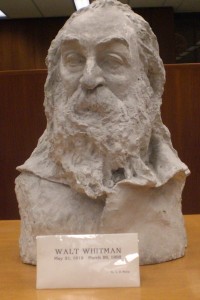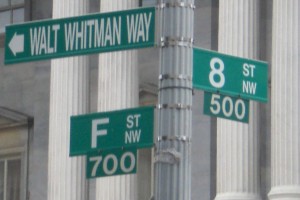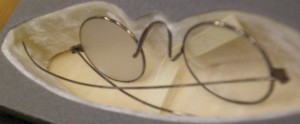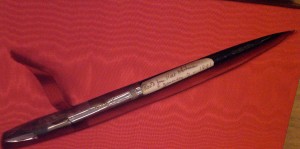Archive for November, 2009
One of the most tranquil field trips ever: Whitman’s Cemetery
Who would’ve ever thought cemeteries could be so beautiful, let alone tranquil? When one thinks of cemeteries, what comes to mind? For me, I think of rough-cornered tombstones; dark, mist-filled nights; black cats; not little cute ghosts like Casper, but you know, the real ones, the real ghosts. Well, maybe that was a bit too over-exaggerated. But really. Would would’ve thought that Whitman’s cemetery would be like that of an actual haven? Not only do we find real nature scenes coming to life in Whitman’s poetry, but he even brings them to life after death. His tomb was literally coming out from the ground. Surrounded by nature, literally connected with roots from trees, it was almost as if Whitman was a part of the ground… the grass. It was amazing. The experience was so tranquil and beautiful… This may sound a bit bizarre, but it was so nice that if I could, I would want to live nearby somewhere by the pond beside Whitman’s grave. Don’t get me wrong, I’m pretty sane. You just have to experience going to Whitman’s cemetery yourself to see what I mean.

One of the most tranquil field trips ever: Whitman’s Cemetery
Who would’ve ever thought cemeteries could be so beautiful, let alone tranquil? When one thinks of cemeteries, what comes to mind? For me, I think of rough-cornered tombstones; dark, mist-filled nights; black cats; not little cute ghosts like Casper, but you know, the real ones, the real ghosts. Well, maybe that was a bit too over-exaggerated. But really. Would would’ve thought that Whitman’s cemetery would be like that of an actual haven? Not only do we find real nature scenes coming to life in Whitman’s poetry, but he even brings them to life after death. His tomb was literally coming out from the ground. Surrounded by nature, literally connected with roots from trees, it was almost as if Whitman was a part of the ground… the grass. It was amazing. The experience was so tranquil and beautiful… This may sound a bit bizarre, but it was so nice that if I could, I would want to live nearby somewhere by the pond beside Whitman’s grave. Don’t get me wrong, I’m pretty sane. You just have to experience going to Whitman’s cemetery yourself to see what I mean.

Photos from the Brooklyn Historical Society Visit
Here are some photos taken during the visit that the City Tech class made to the Brooklyn Historical Society on November 3rd. The trip was part of a new research project in which each student in the course chose an address in which Whitman lived briefly during his time in Brooklyn. Students will perform historical research on the address using insurance maps, land conveyances, city directories, and other resources provided by the BHS. Many thanks to the BHS and librarian Elizabeth Call for their assistance with this project.
Here are some recaps of the trip from students in the course:
-
techwhit: Brooklyn Historical Museum Visit
fabfab: BHS Recap
oatakan: Old, Cold and Cool Place
jenniferying: jennifer for nov 10
Photos from the Brooklyn Historical Society Visit
Here are some photos taken during the visit that the City Tech class made to the Brooklyn Historical Society on November 3rd. The trip was part of a new research project in which each student in the course chose an address in which Whitman lived briefly during his time in Brooklyn. Students will perform historical research on the address using insurance maps, land conveyances, city directories, and other resources provided by the BHS. Many thanks to the BHS and librarian Elizabeth Call for their assistance with this project.
Here are some recaps of the trip from students in the course:
-
techwhit: Brooklyn Historical Museum Visit
fabfab: BHS Recap
oatakan: Old, Cold and Cool Place
jenniferying: jennifer for nov 10
Brooklyn Historical Museum Visit
New York City College of Technology Whitman class made a field trip to the Brooklyn Historical Society on November 3, 2009. We met in front of the Brooklyn Historical Society with Professor Gold where we greeted by Elizabeth Call. She is the Special Collections Librarian and has immense knowledge of resources available at the Museum. Some of these resources are:
- Historic Atlases
- Land Conveyances
- Brooklyn Directories
- Brooklyn and Long Island Scrapbook Collection
- An extensive image database
- Real Estate Brochure Collection
- Architecture Books
I will see if I can get a digital copy of the handout discussing these sources.
Thanks to the generosity of the NEH Office for Digital Humanities, we have a semester pass to the museum and library. We can find sources from Brooklyn we can’t find anywhere else. This blog post is a highlight of some of the things we saw.
Upon entering, I wondered why the class made a trip here. Professor Gold told us we would be using this resource for our next project. We are going to become experts of a particular historical Whitman location. We will be looking for pieces of history around the city, especially Brooklyn using the aforementioned resources.
This library was literally old school. It had card catalogs and microfiche repositories; I haven’t seen one of those in years.

From Wikimedia
We took a look at the Atlas maps from different time periods. I didn’t know that such precise records were kept of Brooklyn in the 19th Century. The class saw Atlas maps from the 1820s up to the 1920s. Brooklyn has changed substantially. This will make our historical location project more difficult. In some cases, some streets may not exist in the past.

In the diagram above, you can see small boxes that are pink and yellow. Yellow stands for wood while pink stands for stone. The building numbers and block numbers are even on the map along with another slew of details.
The library has the Brooklyn City Directories that are something like our phonebooks today. These were published periodically in the past. This link is an example of the physical resource. You can look for someone’s name and find out where he or she lives and their profession. I could link the name to an address and then pull up a map to see where they lived. With their name, I can do research on them and do some follow up work. Elizabeth even found Walt Whitman’s father but not his son.
The Library even has the Brooklyn Daily Eagle from 1841-1950s. I can be sure I can find many of Whitman’s journalism articles in that collection in their original form.

Because this library has so many resources, many people visit it to prove that an area or a building is a landmark. Elizabeth Call (our guide) gave us a helpful tip when it comes to researching our sites. She said, “check if the address is in a landmarked neighborhood”. If it is, you can find a wealth of information due to its landmark status and significance. Anyone can get a historical perspective of Brooklyn through the library’s historical documents.
The library was particularly cold, old books don’t like moisture and the air conditioner was on full blast the duration of the trip. From the Atlas maps to the articles, and scrapbooks down to the deeds, we can uncover pieces of history and bring them together.

The library is open Wednesday to Friday from 1-5 PM. My classmates will be sure to visit this incredible resource that I didn’t know existed in our search for Whitman.
Brooklyn Historical Museum Visit
New York City College of Technology Whitman class made a field trip to the Brooklyn Historical Society on November 3, 2009. We met in front of the Brooklyn Historical Society with Professor Gold where we greeted by Elizabeth Call. She is the Special Collections Librarian and has immense knowledge of resources available at the Museum. Some of these resources are:
- Historic Atlases
- Land Conveyances
- Brooklyn Directories
- Brooklyn and Long Island Scrapbook Collection
- An extensive image database
- Real Estate Brochure Collection
- Architecture Books
I will see if I can get a digital copy of the handout discussing these sources.
Thanks to the generosity of the NEH Office for Digital Humanities, we have a semester pass to the museum and library. We can find sources from Brooklyn we can’t find anywhere else. This blog post is a highlight of some of the things we saw.
Upon entering, I wondered why the class made a trip here. Professor Gold told us we would be using this resource for our next project. We are going to become experts of a particular historical Whitman location. We will be looking for pieces of history around the city, especially Brooklyn using the aforementioned resources.
This library was literally old school. It had card catalogs and microfiche repositories; I haven’t seen one of those in years.

From Wikimedia
We took a look at the Atlas maps from different time periods. I didn’t know that such precise records were kept of Brooklyn in the 19th Century. The class saw Atlas maps from the 1820s up to the 1920s. Brooklyn has changed substantially. This will make our historical location project more difficult. In some cases, some streets may not exist in the past.

In the diagram above, you can see small boxes that are pink and yellow. Yellow stands for wood while pink stands for stone. The building numbers and block numbers are even on the map along with another slew of details.
The library has the Brooklyn City Directories that are something like our phonebooks today. These were published periodically in the past. This link is an example of the physical resource. You can look for someone’s name and find out where he or she lives and their profession. I could link the name to an address and then pull up a map to see where they lived. With their name, I can do research on them and do some follow up work. Elizabeth even found Walt Whitman’s father but not his son.
The Library even has the Brooklyn Daily Eagle from 1841-1950s. I can be sure I can find many of Whitman’s journalism articles in that collection in their original form.

Because this library has so many resources, many people visit it to prove that an area or a building is a landmark. Elizabeth Call (our guide) gave us a helpful tip when it comes to researching our sites. She said, “check if the address is in a landmarked neighborhood”. If it is, you can find a wealth of information due to its landmark status and significance. Anyone can get a historical perspective of Brooklyn through the library’s historical documents.
The library was particularly cold, old books don’t like moisture and the air conditioner was on full blast the duration of the trip. From the Atlas maps to the articles, and scrapbooks down to the deeds, we can uncover pieces of history and bring them together.

The library is open Wednesday to Friday from 1-5 PM. My classmates will be sure to visit this incredible resource that I didn’t know existed in our search for Whitman.
Searching for Whitman in DC
Walking back to my apartment on October 24th, 2009 after twelve hours of “Whitman Searching” in the DC rain, my body was tired and aching but my mind was racing because I had discovered a new dimension to Whitman that I had never experienced before. Walt Whitman was once a name that I would glance over in a book, the name “Whitman” would blend into Henry David Thoreau, Ralph Waldo Emerson, and the millions of other American canonical authors. But after trudging through the streets of DC the name Walt Whitman would was no longer a historical author who wrote American poetry, but, finally for me, he was an actual human being just like you or I.
Sometimes when we talk in class about Whitman, I feel as though we are honoring this perfect nonhuman being. Prior to the field trip, it was hard for me to fathom the fact that Whitman was someone who had human faults and weaknesses. Rather, I always believed Whitman was this ideal prophet-like individual with awe inspiring ideas and who could foresee the future of America.
The picture of the Bust of Whitman created by S.H. Morse and the street sign depicted my view of Whitman prior to the field trip.


I thought of Whitman as this statue like person who was greater both physically and mentally than any other human. I associated Whitman as a Moses like figure leading his people. At the same time however, Whitman’s names was still associated as a “historical figure” who happened to be recognized for his talents and who like many other famous individuals had streets and buildings named after him.
But, this misconstrued idea of Whitman was slowly broken down throughout the day. Walking down Constitution Ave, standing at Freedom Plaza, and entering into the grand Willard Hotel I began to see how Whitman too had to walk these same streets. Although DC in 2009 is much different than the DC Whitman experienced from 1863-1873, these lines from Brooklyn Ferry stand out in my mind when trying to put into words how Whitman’s humanity was discovered.
“Just as you feel when you look on the river and sky, so I felt,
Just as any of you is one of a living crowd, I was one of a crowd,
Just as you are refresh’d by the gladness of the river and the
bright flow, I was refresh’d”
This discovery of the human Whitman continued as I saw firsthand Whitman’s personal possessions. Although I was deeply moved at the unveiling of the haversack, what captivated my attention the most was Walt Whitman’s glasses and pen.


This picture of Whitman’s glasses show how Whitman had physical ailments and was affected by the outside world around him. The right eye is frosted over and as Barbara Bair, the librarian at the Library of Congress told us, his loss of eyesight in an eye could have been due to the multiple strokes that Whitman had during the later years of his life. So seeing these glasses made me realize that Whitman although brilliant was not perfect.
The pen is a reed that was Whitman’s in 1891. The simple reed pen, changed my perception of how Whitman did not miraculously create his works, but rather, he tirelessly labored pen in hand over paper. Much like what we, as students, do today. So, although Walt Whitman’s work is under the category of canonical American literature, Whitman is no longer a name to me. After this trip Whitman is human just like you and I.
Searching for Whitman in DC
Walking back to my apartment on October 24th, 2009 after twelve hours of “Whitman Searching” in the DC rain, my body was tired and aching but my mind was racing because I had discovered a new dimension to Whitman that I had never experienced before. Walt Whitman was once a name that I would glance over in a book, the name “Whitman” would blend into Henry David Thoreau, Ralph Waldo Emerson, and the millions of other American canonical authors. But after trudging through the streets of DC the name Walt Whitman would was no longer a historical author who wrote American poetry, but, finally for me, he was an actual human being just like you or I.
Sometimes when we talk in class about Whitman, I feel as though we are honoring this perfect nonhuman being. Prior to the field trip, it was hard for me to fathom the fact that Whitman was someone who had human faults and weaknesses. Rather, I always believed Whitman was this ideal prophet-like individual with awe inspiring ideas and who could foresee the future of America.
The picture of the Bust of Whitman created by S.H. Morse and the street sign depicted my view of Whitman prior to the field trip.


I thought of Whitman as this statue like person who was greater both physically and mentally than any other human. I associated Whitman as a Moses like figure leading his people. At the same time however, Whitman’s names was still associated as a “historical figure” who happened to be recognized for his talents and who like many other famous individuals had streets and buildings named after him.
But, this misconstrued idea of Whitman was slowly broken down throughout the day. Walking down Constitution Ave, standing at Freedom Plaza, and entering into the grand Willard Hotel I began to see how Whitman too had to walk these same streets. Although DC in 2009 is much different than the DC Whitman experienced from 1863-1873, these lines from Brooklyn Ferry stand out in my mind when trying to put into words how Whitman’s humanity was discovered.
“Just as you feel when you look on the river and sky, so I felt,
Just as any of you is one of a living crowd, I was one of a crowd,
Just as you are refresh’d by the gladness of the river and the
bright flow, I was refresh’d”
This discovery of the human Whitman continued as I saw firsthand Whitman’s personal possessions. Although I was deeply moved at the unveiling of the haversack, what captivated my attention the most was Walt Whitman’s glasses and pen.


This picture of Whitman’s glasses show how Whitman had physical ailments and was affected by the outside world around him. The right eye is frosted over and as Barbara Bair, the librarian at the Library of Congress told us, his loss of eyesight in an eye could have been due to the multiple strokes that Whitman had during the later years of his life. So seeing these glasses made me realize that Whitman although brilliant was not perfect.
The pen is a reed that was Whitman’s in 1891. The simple reed pen, changed my perception of how Whitman did not miraculously create his works, but rather, he tirelessly labored pen in hand over paper. Much like what we, as students, do today. So, although Walt Whitman’s work is under the category of canonical American literature, Whitman is no longer a name to me. After this trip Whitman is human just like you and I.
Searching for Whitman in DC
Walking back to my apartment on October 24th, 2009 after twelve hours of “Whitman Searching” in the DC rain, my body was tired and aching but my mind was racing because I had discovered a new dimension to Whitman that I had never experienced before. Walt Whitman was once a name that I would glance over in a book, the name “Whitman” would blend into Henry David Thoreau, Ralph Waldo Emerson, and the millions of other American canonical authors. But after trudging through the streets of DC the name Walt Whitman would was no longer a historical author who wrote American poetry, but, finally for me, he was an actual human being just like you or I.
Sometimes when we talk in class about Whitman, I feel as though we are honoring this perfect nonhuman being. Prior to the field trip, it was hard for me to fathom the fact that Whitman was someone who had human faults and weaknesses. Rather, I always believed Whitman was this ideal prophet-like individual with awe inspiring ideas and who could foresee the future of America.
The picture of the Bust of Whitman created by S.H. Morse and the street sign depicted my view of Whitman prior to the field trip.


I thought of Whitman as this statue like person who was greater both physically and mentally than any other human. I associated Whitman as a Moses like figure leading his people. At the same time however, Whitman’s names was still associated as a “historical figure” who happened to be recognized for his talents and who like many other famous individuals had streets and buildings named after him.
But, this misconstrued idea of Whitman was slowly broken down throughout the day. Walking down Constitution Ave, standing at Freedom Plaza, and entering into the grand Willard Hotel I began to see how Whitman too had to walk these same streets. Although DC in 2009 is much different than the DC Whitman experienced from 1863-1873, these lines from Brooklyn Ferry stand out in my mind when trying to put into words how Whitman’s humanity was discovered.
“Just as you feel when you look on the river and sky, so I felt,
Just as any of you is one of a living crowd, I was one of a crowd,
Just as you are refresh’d by the gladness of the river and the
bright flow, I was refresh’d”
This discovery of the human Whitman continued as I saw firsthand Whitman’s personal possessions. Although I was deeply moved at the unveiling of the haversack, what captivated my attention the most was Walt Whitman’s glasses and pen.


This picture of Whitman’s glasses show how Whitman had physical ailments and was affected by the outside world around him. The right eye is frosted over and as Barbara Bair, the librarian at the Library of Congress told us, his loss of eyesight in an eye could have been due to the multiple strokes that Whitman had during the later years of his life. So seeing these glasses made me realize that Whitman although brilliant was not perfect.
The pen is a reed that was Whitman’s in 1891. The simple reed pen, changed my perception of how Whitman did not miraculously create his works, but rather, he tirelessly labored pen in hand over paper. Much like what we, as students, do today. So, although Walt Whitman’s work is under the category of canonical American literature, Whitman is no longer a name to me. After this trip Whitman is human just like you and I.
Searching for Whitman in DC
Walking back to my apartment on October 24th, 2009 after twelve hours of “Whitman Searching” in the DC rain, my body was tired and aching but my mind was racing because I had discovered a new dimension to Whitman that I had never experienced before. Walt Whitman was once a name that I would glance over in a book, the name “Whitman” would blend into Henry David Thoreau, Ralph Waldo Emerson, and the millions of other American canonical authors. But after trudging through the streets of DC the name Walt Whitman would was no longer a historical author who wrote American poetry, but, finally for me, he was an actual human being just like you or I.
Sometimes when we talk in class about Whitman, I feel as though we are honoring this perfect nonhuman being. Prior to the field trip, it was hard for me to fathom the fact that Whitman was someone who had human faults and weaknesses. Rather, I always believed Whitman was this ideal prophet-like individual with awe inspiring ideas and who could foresee the future of America.
The picture of the Bust of Whitman created by S.H. Morse and the street sign depicted my view of Whitman prior to the field trip.


I thought of Whitman as this statue like person who was greater both physically and mentally than any other human. I associated Whitman as a Moses like figure leading his people. At the same time however, Whitman’s names was still associated as a “historical figure” who happened to be recognized for his talents and who like many other famous individuals had streets and buildings named after him.
But, this misconstrued idea of Whitman was slowly broken down throughout the day. Walking down Constitution Ave, standing at Freedom Plaza, and entering into the grand Willard Hotel I began to see how Whitman too had to walk these same streets. Although DC in 2009 is much different than the DC Whitman experienced from 1863-1873, these lines from Brooklyn Ferry stand out in my mind when trying to put into words how Whitman’s humanity was discovered.
“Just as you feel when you look on the river and sky, so I felt,
Just as any of you is one of a living crowd, I was one of a crowd,
Just as you are refresh’d by the gladness of the river and the
bright flow, I was refresh’d”
This discovery of the human Whitman continued as I saw firsthand Whitman’s personal possessions. Although I was deeply moved at the unveiling of the haversack, what captivated my attention the most was Walt Whitman’s glasses and pen.


This picture of Whitman’s glasses show how Whitman had physical ailments and was affected by the outside world around him. The right eye is frosted over and as Barbara Bair, the librarian at the Library of Congress told us, his loss of eyesight in an eye could have been due to the multiple strokes that Whitman had during the later years of his life. So seeing these glasses made me realize that Whitman although brilliant was not perfect.
The pen is a reed that was Whitman’s in 1891. The simple reed pen, changed my perception of how Whitman did not miraculously create his works, but rather, he tirelessly labored pen in hand over paper. Much like what we, as students, do today. So, although Walt Whitman’s work is under the category of canonical American literature, Whitman is no longer a name to me. After this trip Whitman is human just like you and I.